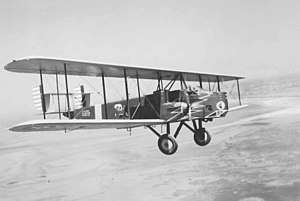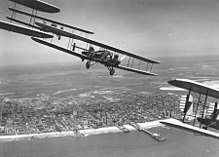Curtiss B-2 Condor
The Curtiss B-2 Condor was a 1920s United States bomber aircraft. It was a descendant of the Martin NBS-1, which was built by the Curtiss Aeroplane and Motor Company for the Glenn L. Martin Company. There were a few differences, such as stronger materials and different engines, but they were relatively minor.
| B-2 Condor | |
|---|---|
 | |
| Role | Heavy bomber |
| Manufacturer | Curtiss Aeroplane and Motor Company |
| Introduction | 1929 |
| Retired | 1934 |
| Status | No known survivors |
| Primary user | United States Army Air Corps |
| Produced | 1929-1930 |
| Number built | 13 |
| Unit cost |
US$76,373 (1928) |
| Developed into | T-32 Condor II |

Development
The B-2 was a large fabric-covered biplane aircraft. Its two engines sat in nacelles between the wings, flanking the fuselage. It had a twin set of rudders on a twin tail, a configuration which was becoming obsolete by that time. At the rear of each nacelle was a gunner position. In previous planes, the back-facing gunners had been in the fuselage, but their view there was obstructed. A similar arrangement (using nacelle-mounted gun platforms) was adopted in the competing Keystone XB-1 aircraft.
The XB-2 competed for a United States Army Air Corps production contract with the similar Keystone XB-1, Sikorsky S-37, and Fokker XLB-2. The other three were immediately ruled out, but the Army board appointed to make the contracts was strongly supportive of the smaller Keystone XLB-6, which cost a third as much as the B-2. Furthermore, the B-2 was large for the time and difficult to fit into existing hangars. However, the superior performance of the XB-2 soon wrought a policy change, and in 1928 a production run of 12 was ordered.
One modified B-2, dubbed the B-2A, featured dual controls for both the pilot and the copilot. Previously, the control wheel and the pitch controls could only be handled by one person at a time. This "dual control" setup became standard on all bombers by the 1930s. There was no production line for the B-2A. The B-2 design was also used as a transport.
The B-2 was quickly made obsolete by technological advances of the 1930s, and served only briefly with the Army Air Corps, being removed from service by 1934. Following production of the B-2, Curtiss Aircraft left the bomber business, and concentrated on the Hawk series of pursuit aircraft in the 1930s.
Variants
- Model 52
- Company designation of the B-2.
- XB-2
- Prototype.
- B-2
- Twin-engined heavy bomber biplane. Initial production version; 12 built.
- B-2A
- Redesignation of one B-2 fitted with dual controls.
- Model 53 Condor 18
- Civil version of the B-2. Six built.
Military operators
- US Army Air Corps
- 7th Bombardment Group, Rockwell Field, California
- 11th Bomb Squadron - operated 1928-1931
- 7th Bombardment Group, Rockwell Field, California
Specifications (B-2)
Data from Curtiss aircraft : 1907-1947[1]
General characteristics
- Crew: 5
- Length: 47 ft 4 in (14.43 m)
- Wingspan: 90 ft 0 in (27.43 m)
- Airfoil: root: Curtiss C-72; tip: Curtiss C-72[2]
- Empty weight: 9,300 lb (4,218 kg)
- Gross weight: 16,951 lb (7,689 kg)
- Powerplant: 2 × Curtiss GV-1570-7 Conqueror V-12 water-cooled piston engine, 600 hp (450 kW) each
Performance
- Maximum speed: 132 mph (212 km/h, 115 kn)
- Cruise speed: 105.5 mph (169.8 km/h, 91.7 kn)
- Range: 805 mi (1,296 km, 700 nmi)
- Service ceiling: 17,100 ft (5,200 m)
- Rate of climb: 850 ft/min (4.3 m/s)
Armament
- Guns: 6x 0.30 in (7.62 mm) Lewis machine-guns
- Bombs: 2,508 lb (1,138 kg) of bombs.
See also
Related development
Aircraft of comparable role, configuration and era
- Fokker XLB-2
- Huff-Daland XB-1
- Huff-Daland XHB-1
- Keystone LB-7
- Sikorsky S-37
Related lists
References
- Bowers, Peter M. (1979). Curtiss aircraft : 1907-1947. London: Putnam. pp. 213–215. ISBN 0-370-10029-8.
- Lednicer, David. "The Incomplete Guide to Airfoil Usage". m-selig.ae.illinois.edu. Retrieved 16 April 2019.
- Bowers, Peter M. Curtiss Aircraft 1907-1947. London: Putnam & Company Ltd., 1979. ISBN 0-370-10029-8.
External links
| Wikimedia Commons has media related to Curtiss B-2. |
- Curtis B-2 Condor page of Joe Baugher, part of his Encyclopedia of American Aircraft
- USAF Museum article on B-2
- "New Flying Battleship". Modern Mechanix. October 1927.